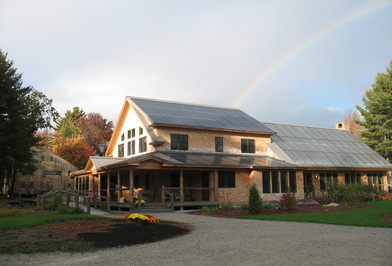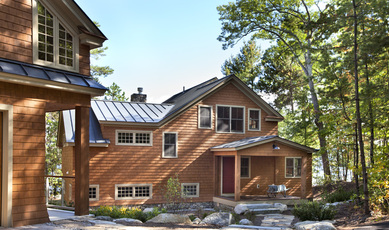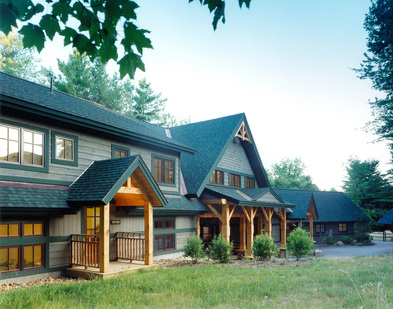Sustainable Building Practices
Our firm has been involved with sustainable ("green") building design since 1984. Energy efficiency is tremendously important to our clients. Incorporating the use of solar energy and using local materials, using natural landscaping and hardscaping techniques, radiant flooring and geothermal systems to reduce fossil fuel usage is a big part of the picture.

The Tin Mountain Conservation Center is a 6,400 square foot net-zero energy facility located in Albany, New Hampshire. The center includes proprietary solar thermal and solar/photovoltaic systems integrated into the building's roof. Extensive energy modeling was done to compare costs with benefits, which were constantly balanced. The building includes 20 different locally harvested woods that are featured in various rooms as finish as an exhibit of the woods as part of the TMCC's educational objective. The state of the art solar building provides an excellent teaching platform for promoting sustainable energy systems, energy conservation choices and the use of locally produced wood products. This project won the 2007 Plan New Hampshire Merit Award for Excellence, and an Honorable Mention for Sustainable Design in 2008 from AIA New Hampshire Integrated Design/Integrated Development Program.

The owner of this new five bedroom home fully embraced the ethos of the LEED process when, due to health and safety reasons, they decided to demolish and replace an existing structure with a new energy efficient home of a similar character and style. The home received LEED Platinum certification. The project began with a meeting of members of the Design Team to agree on an overall LEED standard to aim for and some realistic goals within that standard. The design of the new home, utilizing the footprint of the existing structure and some additional space followed, while the existing structure was dismantled and recycled, attaining a recycle rate between 95%-100% depending on the materials and components, with virtually no debris going into landfill.

The new 2,500 square foot Visitor Center at the Squam Lakes Natural Science Center in Holderness, New Hampshire acts as an educational tool and the welcome area to all visitors. Environmentally appropriate systems installed at the center include a composting toilet system, solar hot water panels, and photovoltaic panels to generate electricity. Natural materials were used throughout the project which also includes the retail shop, open-air entry and administrative office space.